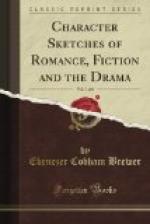She then proceeds to ransack the room for bonds, leases, and money; but Argan starts up and tells her she has taught him one useful lesson for life at any rate.—Moliere, Le Malade Imaginaire (1673).
BELISA’RIUS, the greatest of Justinian’s generals. Being accused of treason, he was deprived of all his property, and his eyes were put out. In this state he retired to Constantinople, where he lived by begging. The story says he fastened a label to his hat, containing these words, “Give an obolus to poor old Belisarius.” Marmontel has written a tale called Belisaire, which has helped to perpetuate these fables, originally invented by Tzetzes or Caesios, a Greek poet, born at Constantinople in 1120.
BELISE (2 syl.), sister of Philaminte (3 syl.), and, like her, a femme savante. She imagines that every one is in love with her.—Moliere, Les Femmes Savantes (1672).
BELL (Adam), a wild, north-country outlaw, noted, like Robin Hood, for his skill in archery. His place of residence was Englewood Forest, near Carlisle; and his two comrades were Clym of the Clough [Clement of the Cliff] and William of Cloudesly (3 syl.). William was married, but the other two were not. When William was captured at Carlisle, and was led to execution, Adam and Clym rescued him, and all three went to London to crave pardon of the king, which, at the queen’s intercession, was granted them. They then showed the king specimens of their skill in archery, and the king was so well pleased that he made William a “gentleman of fe,” and the two others yeomen of the bedchamber.—Percy, Reliques ("Adam Bell,” etc.), I. ii. I.
Bell. Anne, Charlotte, and Emily Bronte assumed the noms de plume of Acton, Currer, and Ellis Bell (first half of the nineteenth century). Currer Bell or Bronte married the Rev. Arthur Bell Nicholls. She was the author of Jane Eyre.
It will be observed that the initial letter of both names is in every case preserved throughout—Acton (Anne), Currer (Charlotte), Ellis (Emily), and Bell (Bronte).
Bell (Bessy). Bessy Bell and Mary Gray were the daughters of two country gentlemen near Perth. When the plague broke out in 1666 they built for themselves a bower in a very romantic spot called Burn Braes, to which they retired, and were supplied with food, etc., by a young man who was in love with both of them. The young man caught the plague, communicated it to the two young ladies, and all three died.—Allan Eamsay, Bessy Bell and Mary Gray (a ballad).
Bell (Peter), the subject of a “tale in verse” by Wordsworth. Shelley wrote a burlesque upon it, entitled Peter Bell the Third.
Bell (The Old Chapel) J. G. Saxe’s poem under this title is founded upon a legend of a boy, who, wandering in a churchyard, hears a musical articulate murmur from a disused bell hidden by matted grass.




